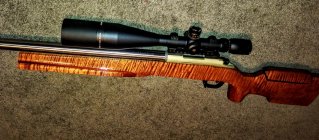I'll add a little insight since I have been asked this question or one exactly like it many times.
In the later post, you mentioned giving F-Class a try, but then also mentioned you were basically shooting from a makeshift set-up off a picnic table. This part of your posting is pivotal since it adds to the picture.
Along with the description of your rig, and without know much detail about your loading process, we know two things that are important, well really three counting the idea that you are probably not a trust fund baby.
You didn't specifically ask for advice on other equipment, but before you go too far down the loading rabbit hole, make sure you understand what F-Class really is, or what shooting "1/4 MOA" really costs in time and money. I would recommend you also consider the style of front rest and rear bags you will want, as well as your scope. That said...
Yes, you are right to assume you will need to up your loading process game when you start asking about F-Class. The F-Class score rings are smaller than the ones used for sling class, so the ammo needs to hold inside the X-Ring or you will eventually get frustrated. Start with a goal of an honest 20 shots inside 1 MOA, then work on 3/4, 1/2 etc. Three strings of 20 shots is not the same as group shooting or agg shooting.
This is when shooting F-Class and Bench Rest begin to differ. Clearly the most accurate ammo is the goal, but you are also looking at needing to evaluate a balance between Benchrest state of the art, versus F-Class demands. Both games are challenging, but while they share many common loading habits, most of us cannot afford the discipline of full up benchrest processing when shooting F-Class or sling. We can also still be very competitive with ammo that won't play at benchrest.
Give the rig a try with what you have now and add the front rest as soon as you can. A poor shooting technique can frustrate you when trying to evaluate any changes to your loading process. If you can't shoot well from a typical prone position, then it wouldn't matter what ammo we feed the gun.
Take the advice of D-4297 and go watch an F-Class match in person. You will see that there is a ranking based on your percentages. It does take some time to climb those levels, so you will have some time to advance your loading process as you gain shooting experience.
I'm sorry to hear they were not welcoming or helpful, but hazing is common in some clubs, but not all. Either find the next one, or be tenacious. Sometimes they act that way to scare off those that are faint of heart cause they won't cut the competition later on anyway. Keep trying and they will see you don't give up easy.
My opinion isn't valuable, but since we are offering it for free, I will say too many folks don't stick with the game when they fail to strike a good balance between the arrow and the Indian. You have a great rig to start out. We are going to have to see what your current loading practice can do before we send you down the rabbit hole. There are many High Masters who's loading process is very basic and does not include many high end steps. They may up their process a little for 1000, but you will find many don't do anything special at 600 for example.
Start by base lining your current loading process at something like 200 yards, and if you feel okay work out to 300. When you can run 20 shots for record and hold a decent score at 300, work out to 600 to see what the wind is like, but don't bother with 600 unless your vertical holds at 300 are good. (In a good rig, even mediocre ammo can compete at 300 yards. The difference in velocity stats start to show from there out.)
Learning wind does take time, but when you are shooting well enough to see the difference between what is your fault versus the ammo, then you are ready for moving up your game. The sooner you can shoot past 300 yards and start at 600, the better.
It is then we can evaluate the contribution of neck prep and load stats. By then, you will start to get the hang of batch controls. There is nothing wrong with doing the research and asking questions ahead of time. These days, tools can take as long to find as materials.
Good reference books are helpful too. I would give a recommendation to the books by Bryan Litz, as well as the ones by the late Glen Zediker on "Top Grade Ammo" and "Hand Loading for Competition".
Be tenacious and don't give up. Ask as many questions as you like, but/and, be prepared to do your own testing. Good Luck!











